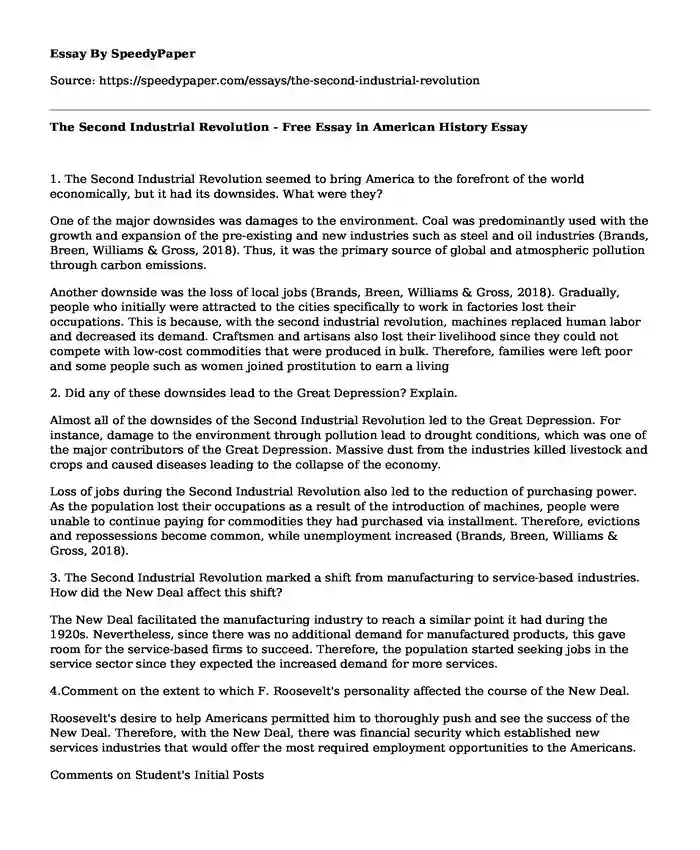
| Type of paper: | Creative writing |
| Categories: | American history Industrial revolution |
| Pages: | 3 |
| Wordcount: | 821 words |
1. The Second Industrial Revolution seemed to bring America to the forefront of the world economically, but it had its downsides. What were they?
One of the major downsides was damages to the environment. Coal was predominantly used with the growth and expansion of the pre-existing and new industries such as steel and oil industries (Brands, Breen, Williams & Gross, 2018). Thus, it was the primary source of global and atmospheric pollution through carbon emissions.
Another downside was the loss of local jobs (Brands, Breen, Williams & Gross, 2018). Gradually, people who initially were attracted to the cities specifically to work in factories lost their occupations. This is because, with the second industrial revolution, machines replaced human labor and decreased its demand. Craftsmen and artisans also lost their livelihood since they could not compete with low-cost commodities that were produced in bulk. Therefore, families were left poor and some people such as women joined prostitution to earn a living
2. Did any of these downsides lead to the Great Depression? Explain.
Almost all of the downsides of the Second Industrial Revolution led to the Great Depression. For instance, damage to the environment through pollution lead to drought conditions, which was one of the major contributors of the Great Depression. Massive dust from the industries killed livestock and crops and caused diseases leading to the collapse of the economy.
Loss of jobs during the Second Industrial Revolution also led to the reduction of purchasing power. As the population lost their occupations as a result of the introduction of machines, people were unable to continue paying for commodities they had purchased via installment. Therefore, evictions and repossessions become common, while unemployment increased (Brands, Breen, Williams & Gross, 2018).
3. The Second Industrial Revolution marked a shift from manufacturing to service-based industries. How did the New Deal affect this shift?
The New Deal facilitated the manufacturing industry to reach a similar point it had during the 1920s. Nevertheless, since there was no additional demand for manufactured products, this gave room for the service-based firms to succeed. Therefore, the population started seeking jobs in the service sector since they expected the increased demand for more services.
4.Comment on the extent to which F. Roosevelt's personality affected the course of the New Deal.
Roosevelt's desire to help Americans permitted him to thoroughly push and see the success of the New Deal. Therefore, with the New Deal, there was financial security which established new services industries that would offer the most required employment opportunities to the Americans.
Comments on Student's Initial Posts
Reply to the first Post Posted at 6:50 pm
I agree with you that the Second Industrial Revolution had downsides associated with demand and supply, particularly on the issue of selling to earn more profit. However, you stated that most Americans did not have adequate money to afford it. I have a question up to this point. One, why could the Americans not afford it? Is it due to lack of employment and higher interest on loans? Please explain further.
Conversely, I completely agree with you on the impact of the New Deal on the shift from manufacturing to service-based industries. Indeed, it contributed significantly to the creation of new employment. Nevertheless, I think you should state when the creation of new employment occurred. For instance, you could say after the manufacturing industry attained similar levels it initially had during the 1920s. I can also agree with you that selfless type of attitude as Roosevelt's attribute led him to make a significant effect by pushing and seeing the success of the New Deal.
Reply to the Second Post
I agree with you that the overproduction of goods during the Second Industrial Revolution led to the Great Depression. However, how did it mask the fall of some industries, such as agriculture? Is it because there was more demand for manufactured goods or there was not advanced technology supporting agriculture? Please illustrate further why some industry fell while others expanded and flourished.
On the downsides that led to the Great Depression, you stated that low wages were among the contributing factor. Nevertheless, you did not state this downside in the previous question. I agree that you stated that Americans did not have enough money to buy automobiles. But is it all Americans who did not have enough money? Or was money concentrated in the hands of high or low-class Americans? Please be specific on which social class lacked money.
I completely agree with you on the New Deal and extent to which F. Roosevelt's personality affected it. The New Deal attaining similar levels as those in the 1920s was the gateway to opening the reborn of the service industries. Motivation and persuading characteristic of Roosevelt can also be seen as the leading force to pushing the New Deal.
References
Brands, H. W., Breen, T. H., Williams, R. H., & Gross, A. J. (2018). American stories: A history of the United States (Vol. 2). Pearson.
Cite this page
The Second Industrial Revolution - Free Essay in American History. (2022, Feb 16). Retrieved from https://speedypaper.net/essays/the-second-industrial-revolution
Request Removal
If you are the original author of this essay and no longer wish to have it published on the SpeedyPaper website, please click below to request its removal:
- Free Essay on Intercultural Communication Barriers and Solutions Between Nigeria and China
- Free Essay with Public Address System Research
- Free Essay on the U.S. Policy Issues Towards Latin America
- Essay Sample on Relationship Between Form and Content in E.E. Cummings
- Free Essay: Business and Exchange Rate Changes
- Essay Example about Tourism in Beijing
- Paper Example on Hazard Identification and Risk Assessment
Popular categories




